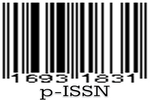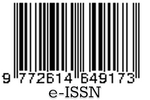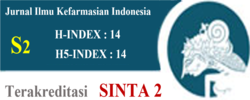Anti-inflammatory effectiveness of Cymbopogon citratus DC. Staff in Na CMC gel preparation
Abstract
Cymbopogon citratus DC. Stapf contains saponins, tannins, and flavonoids. Traditionally, tea from lemongrass leaves is useful as an anti-inflammatory, anti-malarial, anti-mutagenic, anti-mycobacterial, antioxidant, hypoglycemic, and neurobehavioral. A study has been conducted to formulate an anti-inflammatory gel preparation from C. citratus extract. The study was conducted by macerated a C. citratus leafs using 70% ethanol, then evaporated in a rotary evaporator at a temperature of 40 ºC until viscouse extract obtained and evaluated. The anti-inflammatory gel was prepared using Na CMC 6%, with the concentration of C. citratus extract 6%, 8%, and 10%. The resulting gel preparation was evaluated for its physical and chemical properties and then tested for its anti-inflammatory effects using male mice (Mus musculus L.). Flavonoids, alkaloids, tannins, and saponins are found in this C. citratus extract. The characteristics of the C. citratus extract gel made were, brown and dark brown, had a distinctive C. citratus odor, semi-solid, and homogeneous, had a pH of 5.54–5.62, a viscosity value between 57000-73000 cP, had pseudoplastic flow properties, a specific gravity between 1.055-1.078 g/cm3, had an adhesiveness of 231-252 seconds, and a spreadability of 3490.11-3021.20 mm2. The gel contained 10% of C. citratus extract, indicating the highest anti-inflammatory effect, with a decrease in edema diameter of 67.79% in the legs of male mice.
References
[2] T. Kassahun et al., “Ethnobotany, traditional use, phytochemistry and pharmacology of Cymbopogon citratus: Review article,” Int. J. Herb. Med., vol. 8, no. 4, pp. 80–87, 2020.
[3] A. Kiełtyka-Dadasiewicz, J. Esteban, and A. Jabłońska-Trypuć, “Antiviral, Antibacterial, Antifungal, and Anticancer Activity of Plant Materials Derived from Cymbopogon citratus (DC.) Stapf Species”, Pharmaceuticals, vol. 17, no. 6, 2024.
[4] S. Magotra, A. P. Singh, and A. P. Singh, “A review on pharmacological activities of cymbopogon citratus,” Int. J. Pharm. Drug Anal., vol. 1, no. 3, pp. 427–446, 2021.
[5] L. Saptawati et al., “In vitro study of eight Indonesian plants extracts as anti Dengue virus,” Heal. Sci. J. Indones., 2017.
[6] S. Umukoro, B. Ben-Azu, A. M. Ajayi, A. Adebesin, and O. Emokpae, “Cymbopogon citratus aqueous leaf extract attenuates neurobehavioral and biochemical changes induced by social defeat stress in mice,” Chinese Herb. Med., vol. 12, no. 3, pp. 303–309, 2020.
[7] C. Ekpenyong, E. Akpan, and N. Daniel, Phytochemical Constituents, Therapeutic Applications and Toxicological Profile of Cymbopogon citratus Stapf (DC) Leaf Extract. 2014.
[8] C. E. Ekpenyong, E. Akpan, and A. Nyoh, “Ethnopharmacology, phytochemistry, and biological activities of Cymbopogon citratus (DC.) Stapf extracts,” Chin. J. Nat. Med., vol. 13, no. 5, pp. 321–337, 2015.
[9] F. J. Tinahones, “What is happening with antiobesity drugs?,” Endocrinología y Nutrición (English Edition), vol. 58, no. 3. Elsevier BV, pp. 101–103, 2011.
[10] M. Silalahi, “Ethnomedicinal plants and practices related to pregnancy, childbirth, and postpartum healthcare of Minangkabau ethnic group, West Sumatra, Indonesia,” Biodiversitas J. Biol. Divers., 2020.
[11] P. G. Karamkar, A. Agrawal, and V. K. Chatap, “A Review Article: Formulation of Topical Gel by QbD Approach,” Adv. Pharmacol. Pharm., vol. 11, no. 2, pp. 90–101, 2023.
[12] M. Ulfa et al., “Formulasi Gel Ekstrak Daun Kelor (Moringa oleifera Lam.) Sebagai Anti Inflamasi Topikal Pada Tikus (Rattus novergicus),” J. Pharm. Med. Sci., vol. 1, no. 2, pp. 30–35, 2016.
[13] V. F. Putri and G. Setiyadi, “Optimization of SOD-CMC as gelling agent andpropylene glycol as humectant in gel preparation of johar leaf extract (Cassia siamea Lam.),” Usadha J. Pharm., vol. 2, no. 2, pp. 236–246, 2023.
[14] A. C. Mendes Hacke, E. Miyoshi, J. A. Marques, and R. P. Pereira, “Anxiolytic properties of Cymbopogon citratus (DC.) stapf extract, essential oil and its constituents in zebrafish (Danio rerio),” J. Ethnopharmacol., vol.
260, no. May, p. 113036, 2020.
[15] B. M. B. Sikawin, P. V. Y. Yamlean, and S. Sudewi, “Formulasi Sediaan Gel Antibakteri Ekstrak Etanol Tanaman Sereh (Cymbopogon citratus (DC.) Stapf) dan Uji Aktivitas Antibakteri (Staphylococcus aureus) Secara in vitro Bryce,” PHARMACON J. Ilm. Farm., vol. 7, no. 3, pp. 302–310, 2018.
[16] N. Manus, Formulasi Sediaan Gel Minyak Atsiri Daun Sereh (Cymbopogon Citratus) Sebagai Antiseptik Tangan. 2016.
[17] F. N. A. Fahmi, B. Putra, and I. Santi, “Uji Efek Antiinflamasi Ekstrak Etanol Daun Matoa (Pometia pinnata J.R Forst & G. Forst) Pada Tikus Jantan (Rattus norvegicus),” Makassar Nat. Prod. J., vol. 1, no. 2, pp. 33–43, 2023.
[18] E. Sutrisna, Maryati, S. Wahyuni, and S. Tanti Azizah, “Anti-inflammatory effect of Phyllanthus niruri L. From Indonesia (Pre-clinical Study),” Pharmacogn. J., 2019.
[19] J. Necas and L. Bartosikova, “Carrageenan: a review.,” Vet. Med. (Praha)., vol. 58, no. 4, 2013.
[20] O. Setyaningsih, E. Hambali, and M. Nasution, “Aplikasi Minyak Sereh Wangi (Citronella Oil) dan Geraniol Dalam Pembuatan Skin Lotion penolak Nyamuk,” J. Teknol. Indones., vol. 17, no. 3, pp. 97–103, 2007.
[21] E. S. Kuncari, Iskandarsyah, and Praptiwi, “Evaluasi, uji stabilitas fisik dan sineresis sediaan gel yang mengandung minoksidil, apigenin dan perasan herba seledri (Apium graveolens L.),” Bul. Penelit. Kesehat., vol.
42, no. 4, pp. 213–222, 2014.
[22] M. Kulkarni, V. Hastak, and S. Jadhav, “Development and characterization of transdermal delivery system of doxazosin mesylate,” Int. J. Appl. Pharm., vol. 11, no. 1, pp. 43–48, 2019.
[23] M. Uyama, K. Ikuta, T. Teshigawara, K. Watanabe, and R. Miyahara, “The viscosity stability of O/W emulsion containing α-gel through an ionic-complex system,” J. Oleo Sci., vol. 62, no. 1, pp. 9–16, 2013.
[24] D. Saryanti, I. Setiawan, and H. H. Dayanto, “Use of CMC Na as Gelling Agent in Nanoemulgel Formulation of Methanol Extract of Sappan Wood (Caesalpinia sappan L),” J. Trop. Pharm. Chem., vol. 6, no. 1, pp. 21–29, 2022.
[25] M. Silalahi, “Essential Oil pada Cymbopogon citratus (DC.) Stapf Dan Bioaktivitasnya,” Titian Ilmu J. Ilm. Multi Sci., vol. 12, no. 1, pp. 7–13, 2020.
[26] A. Tazi, A. Zinedine, J. M. Rocha, and F. Errachidi, “Review on the pharmacological properties of lemongrass (Cymbopogon citratus) as a promising source of bioactive compounds,” Pharmacol. Res. - Nat. Prod., vol. 3, no. February, p. 100046, 2024.
[27] É. de F. dos Santos et al., “Antitumor, anti-inflammatory, and antioxidant activities of anthocyanins from food and isolated sources: Methodological insights and interactions with the intestinal microbiota,” J. Funct. Foods, vol. 134, no. May, 2025.
[28] A. Muscolo, O. Mariateresa, T. Giulio, and R. Mariateresa, “Oxidative Stress: The Role of Antioxidant Phytochemicals in the Prevention and Treatment of Diseases,” Int. J. Mol. Sci., vol. 25, no. 6, 2024.

This work is licensed under a Creative Commons Attribution-NonCommercial-ShareAlike 4.0 International License.
Licencing
All articles in Jurnal Ilmu Kefarmasian Indonesia are an open-access article, distributed under the terms of the Creative Commons Attribution-NonCommercial-ShareAlike 4.0 International License which permits unrestricted non-commercial used, distribution and reproduction in any medium.
This licence applies to Author(s) and Public Reader means that the users mays :
- SHARE:
copy and redistribute the article in any medium or format - ADAPT:
remix, transform, and build upon the article (eg.: to produce a new research work and, possibly, a new publication) - ALIKE:
If you remix, transform, or build upon the article, you must distribute your contributions under the same license as the original. - NO ADDITIONAL RESTRICTIONS:
You may not apply legal terms or technological measures that legally restrict others from doing anything the license permits.
It does however mean that when you use it you must:
- ATTRIBUTION: You must give appropriate credit to both the Author(s) and the journal, provide a link to the license, and indicate if changes were made. You may do so in any reasonable manner, but not in any way that suggests the licensor endorses you or your use.
You may not:
- NONCOMMERCIAL: You may not use the article for commercial purposes.
This work is licensed under a Creative Commons Attribution-NonCommercial-ShareAlike 4.0 International License.




 Tools
Tools





















